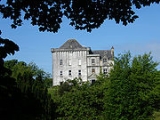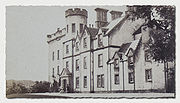
Craignish Castle
Encyclopedia
Craignish Castle, Adfern, Argyllshire, an old baronial architectural build, rebuilt around 1832.
Scottish seat of the Gascoigne family of Parlington Hall
, Lotherton and Castle Oliver
.


, who owned nearly 6000 acres (24 km²) in Argyllshire. Today, the Castle has been converted into apartments and is owned privately.
The seventh laird left only one daughter, Christine Campbell (b. 1323). Her weakness and imprudence caused the majority of the estate to be resigned to the Knight of Lochow, who took advantage of her. She was left with only a small portion of the upper part of Craignish under his superiority. The nearest male representative - Ronald Campbell - fought hard to win back his heritage, and the then Chief of Clan Campbell was obliged to allow him possession of a considerable portion of the estate, but retaining the superiority, and inserting a condition in the grant that if there was ever no male heir in the direct line the lands were to revert automatically to the Argyll family. In 1544 the direct line ended, and the rightful heir, a collateral relative by the name of Charles Campbell of Corranmore in Craignish had the misfortune to kill Gillies of Glenmore in a brawl. This compelled him to flee to Perthshire where he settled at Lochtayside under the protection of the Breadalbane family. This unfortunate event therefore prevented Charles from claiming the estate, and so it fell into the hands of the Earls (later Dukes) of Argyll. Charles' descendants at Killin, Perthshire were later recognised by the Lord Lyon as Chieftains of the Clan Tearlach branch of Clan Campbell and from them descended the Campbells of Inverneill. A grandson of Duncan Campbell 8th of Inverneill in the 1980s owned one of the apartments at Craignish Castle. The arms of Campbell of Inverneill are those of Campbell of Craignish differenced by the addition of "a bordure azure" (a blue border). The first and third Campbells of Inverneill (Sir Archibald Campbell of Inverneill and Sir Janes Campbell of Inverneill Bt were interred at Westminster Abbey in what is now known as Poets Corner. The second, Sir James Campbell of Inverneill and many succeeding Campbells of Inverneill are interred in the Campbell of Inverneill Mausoleum, though the late Dr John Lorne Campbell of Inverneill (and of Canna) is interred on the Isle of Canna where he had lived for over 50 years. The estates of Inverneill, with the exception of the Mausoleum and Inverneill Island, were sold in the 1950s. Inverneill Island remains in the ownership of the present Campbell of Inverneill.
One part of the inheritance which did not revert to the Argylls was the small Barony of Barrichibean, which John Campbell had inherited from his mother's father. This Barony is not currently possessed by anyone today, but genealogical records point to some likely successors.
Edmund Kempt Campbell was created first Baron Campbell of Craignish by the Duke of Saxe-Coburg-Gotha in 1848. He moved to America but was naturalised in Britain some years later. In 1882, Captain Ronald Macleay Lorentz Campbell, his nephew, was ennobled as Baron Craignish by the Duke of Saxe-Coburg-Gotha and applied to Queen Victoria to use the title in Britain. His application was accepted and he was allowed the title 'Baron Campbell von Laurents'. One of these barons was a hero in the Battle of Gravelotte
during the Franco-Prussian war. His son Ronald also used the title, and then it fell to his granddaughter Sarah Elizabeth to become a Peeress In Her Own Right. Baroness Campbell von Laurents published a book in 1913 called 'My Motor Milestones: How to Tour in a Car', and was a member of the Italian Greyhound Club. Her father visited the famous Wright brothers, the inventors of the aeroplane, and a copy of his calling card is preserved in a collection dedicated to the aviators.
The House of Craignish represents thousands of Campbells worldwide, but currently no Chieftain has been identified.
The title 'Baron Campbell von Laurents' is a German title, which was restricted in inheritance to the male line of the original holder, meaning it is now extinct.
Scottish seat of the Gascoigne family of Parlington Hall
Parlington Hall
Parlington Hall was the seat of the Gascoigne family, Aberford near Leeds in the county of Yorkshire, in England. It was the birthplace of Isabella and Elizabeth Oliver Gascoigne, who inherited the Gascoigne family fortune in 1843...
, Lotherton and Castle Oliver
Castle Oliver
Castle Oliver is a Victorian mock castle in the south part of County Limerick, Ireland. Built for entertaining rather than for defense, it has a ballroom, drawing room, library, morning room, dining room and hall which feature hand-painted ceilings, decorated ornamental corbels, superbly executed...
.


Craignish Castle, standing on the peninsula, 2¼ miles from the point, includes a strong old fortalice, which withstood a six weeks' siege by Colkitto, but is mostly a good modern mansion, rebuilt about 1832; its owner, Fred. Chs. Trench-Gascoigne (b. 1814), holds 5591 acres in the shire, valued at £1013 per annum.
Craignish Castle
The founder of the Campbells of Craignish, Dugall Maul Campbell became first Laird of Craignish and his descendants built and resided in Craignish Castle in Argyll. Ranald MacCallum was made hereditary keeper of Craignish Castle in 1510. However, the castle has long since escaped family hands, and in 1832 was rebuilt as a private mansion for Mr. Trench-GascoigneParlington Hall
Parlington Hall was the seat of the Gascoigne family, Aberford near Leeds in the county of Yorkshire, in England. It was the birthplace of Isabella and Elizabeth Oliver Gascoigne, who inherited the Gascoigne family fortune in 1843...
, who owned nearly 6000 acres (24 km²) in Argyllshire. Today, the Castle has been converted into apartments and is owned privately.
Lairds of Craignish
- Dugall Maul Campbell, 1st Laird (1156-????), 1st Chieftain of Campbell of CraignishCampbell of CraignishThe Campbells of Craignish , form one of the oldest branches of the ancient and powerful Clan Campbell in Scotland.. They claim descent from Dugald Campbell, the second son of Sir Archibald Gillespic Campbell , 5th Knight of Lochawe and 20th Chief of Clan Campbell at the time...
- Dougall Campbell, 2nd Laird (1178-1220), 2nd Chieftain
- Dougald Campbell, 3rd Laird (1200-1250), 3rd Chieftain
- Dougall Campbell, 4th Laird (1225-1250), 4th Chieftain
- Malcolm Campbell, 5th Laird (1250-1290), 5th Chieftain
- Dougald Campbell, 6th Laird (1272-????), 6th Chieftain
- Dougald Campbell, 7th Laird (1300-1350), 7th Chieftain
- Christina Campbell, 8th Chieftain
- Ronald Campbell, 8th Laird, 9th Chieftain
- Iain 'Gorm' Campbell, 9th Laird, 10th Chieftain
- Donald Campbell, 10th Laird, 11th Chieftain
- John Campbell, 11th Laird, 2nd Baron of Barrichibean, 12th Chieftain
- Donald Campbell, 3rd Baron, 13th Chieftain
- Iain Campbell, 4th Baron, 14th Chieftain
- Ronald Campbell, 5th Baron, 15th Chieftain
- John Campbell, 6th Baron, 16th Chieftain
- Donald Campbell, 7th Baron, 17th Chieftain
- George Campbell, 8th Baron, 18th Chieftain
- Dugald Campbell, 9th Baron, 19th Chieftain
- Captain Dugald Campbell, 10th Baron, 20th Chieftain
- Colin Campbell, 11th Baron, 21st Chieftain
The seventh laird left only one daughter, Christine Campbell (b. 1323). Her weakness and imprudence caused the majority of the estate to be resigned to the Knight of Lochow, who took advantage of her. She was left with only a small portion of the upper part of Craignish under his superiority. The nearest male representative - Ronald Campbell - fought hard to win back his heritage, and the then Chief of Clan Campbell was obliged to allow him possession of a considerable portion of the estate, but retaining the superiority, and inserting a condition in the grant that if there was ever no male heir in the direct line the lands were to revert automatically to the Argyll family. In 1544 the direct line ended, and the rightful heir, a collateral relative by the name of Charles Campbell of Corranmore in Craignish had the misfortune to kill Gillies of Glenmore in a brawl. This compelled him to flee to Perthshire where he settled at Lochtayside under the protection of the Breadalbane family. This unfortunate event therefore prevented Charles from claiming the estate, and so it fell into the hands of the Earls (later Dukes) of Argyll. Charles' descendants at Killin, Perthshire were later recognised by the Lord Lyon as Chieftains of the Clan Tearlach branch of Clan Campbell and from them descended the Campbells of Inverneill. A grandson of Duncan Campbell 8th of Inverneill in the 1980s owned one of the apartments at Craignish Castle. The arms of Campbell of Inverneill are those of Campbell of Craignish differenced by the addition of "a bordure azure" (a blue border). The first and third Campbells of Inverneill (Sir Archibald Campbell of Inverneill and Sir Janes Campbell of Inverneill Bt were interred at Westminster Abbey in what is now known as Poets Corner. The second, Sir James Campbell of Inverneill and many succeeding Campbells of Inverneill are interred in the Campbell of Inverneill Mausoleum, though the late Dr John Lorne Campbell of Inverneill (and of Canna) is interred on the Isle of Canna where he had lived for over 50 years. The estates of Inverneill, with the exception of the Mausoleum and Inverneill Island, were sold in the 1950s. Inverneill Island remains in the ownership of the present Campbell of Inverneill.
One part of the inheritance which did not revert to the Argylls was the small Barony of Barrichibean, which John Campbell had inherited from his mother's father. This Barony is not currently possessed by anyone today, but genealogical records point to some likely successors.
Edmund Kempt Campbell was created first Baron Campbell of Craignish by the Duke of Saxe-Coburg-Gotha in 1848. He moved to America but was naturalised in Britain some years later. In 1882, Captain Ronald Macleay Lorentz Campbell, his nephew, was ennobled as Baron Craignish by the Duke of Saxe-Coburg-Gotha and applied to Queen Victoria to use the title in Britain. His application was accepted and he was allowed the title 'Baron Campbell von Laurents'. One of these barons was a hero in the Battle of Gravelotte
Battle of Gravelotte
The Battle of Gravelotte was a battle of the Franco-Prussian War named after Gravelotte, a village in Lorraine between Metz and the former French–German frontier.-Terrain and armies:...
during the Franco-Prussian war. His son Ronald also used the title, and then it fell to his granddaughter Sarah Elizabeth to become a Peeress In Her Own Right. Baroness Campbell von Laurents published a book in 1913 called 'My Motor Milestones: How to Tour in a Car', and was a member of the Italian Greyhound Club. Her father visited the famous Wright brothers, the inventors of the aeroplane, and a copy of his calling card is preserved in a collection dedicated to the aviators.
- Edmund Kempt Laurentz Campbell, 1st Baron of Craignish
- Captain Ronald Macleay Lorentz Campbell, 2nd Baron (Campbell von Laurents)
- Ronald Campbell, 3rd Baron (Campbell von Laurents)
- Sarah Elizabeth Campbell, Baroness (Campbell von Laurents)
Incumbent
The title 'Laird of Craignish' is no longer used, because the title 'Laird' conveys a sense of ownership of land, and the Craignish estates were lost long ago (see above). However, most of these properties have since been sold on.The House of Craignish represents thousands of Campbells worldwide, but currently no Chieftain has been identified.
The title 'Baron Campbell von Laurents' is a German title, which was restricted in inheritance to the male line of the original holder, meaning it is now extinct.
Sources
- Parlington Hall the home of the Gascoigne Family who bought Craignish in 1852 for £26,000 Parlington Hall

